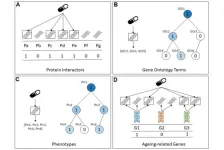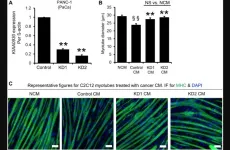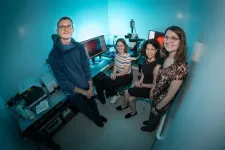Essential cell death-regulating mechanisms important for recovery from SARS-CoV infection and skin injury discovered
2023-07-26
(Press-News.org)
Programmed cell death, a fundamental biological process that facilitates the elimination of old, damaged, infected, and non-functional cells, plays a crucial role in maintaining the balance between health and disease in the human body. Research by the team of Dr Alessandro Annibaldi from the Center for Molecular Medicine Cologne (CMMC) at the University of Cologne has uncovered a novel mechanism of cell death regulation, shedding light on its significance during conditions such as SARS-CoV infection and skin injury. The study ‘Cleavage of cFLIP restrains cell death during viral infection and tissue injury and favors tissue repair’ has now been published in Science Advances.
Cell death and tissue repair
The human body relies on cell death to maintain its normal functions, as it allows the removal of damaged cells and paves the way for the production of new ones. However, an imbalance in cell death can lead to adverse effects, including excessive inflammation and organ failure. Understanding the intricate molecular mechanisms that govern cell death is paramount to deciphering its role in various pathologies and devising bespoke therapeutic strategies for patients suffering from such conditions.
cFLIP cleavage as a novel cell death brake
Annibaldi and his team have made a breakthrough in this area by identifying a new mechanism of cell death regulation involving a molecule called cFLIP. This protein acts as a safeguard against cell death by inhibiting a critical cell death-promoting enzyme known as Caspase-8. Additionally, cFLIP itself becomes a target of Caspase-8 enzymatic activity, being cleaved at amino acid number 377 (D377).
Through cutting-edge cell and molecular biology techniques, the Annibaldi lab were the first to study in mice how cFLIP actually controls cell death in a living organism subjected to stress. They demonstrated that the cleavage of cFLIP at D377 serves as a vital molecular mechanism in limiting the extent of cell death following a viral infection, particularly in the case of SARS-CoV, and skin injury. When cFLIP cannot be cleaved, it leads to the stabilization of a big protein complex, which gains increased killing activity, posing a risk to the organism. Up until this discovery, the significance of this cleavage event had remained unknown.
‘Our study proposes a model where cell death programmes are activated during viral attacks or injuries, but their extent must be carefully controlled to avoid detrimental effects. The cleavage of cFLIP at D377 emerges as one of the key limiting mechanisms that ensure only the necessary number of cells die and promote the restoration of healthy conditions’, said Dr Kristel Lagunas, first author of the study.
The results of this study not only deepen our understanding of cell death regulatory mechanisms but also holds promise for correlating specific genetic mutations in patients with a heightened susceptibility to the lethal effects of viral infections or skin injuries.
END
ELSE PRESS RELEASES FROM THIS DATE:
2023-07-26
New Haven, Conn. — A genetic analysis suggests that the servants and retainers who lived, worked, and died at Machu Picchu, the renowned 15th century Inca palace in southern Peru, were a diverse community representing many different ethnic groups from across the Inca empire.
The genomic data, described in a new study in Science Advances, is the first investigation of the genomic diversity of individuals buried at Machu Picchu and adjacent places around Cusco, the Inca capital. It builds upon previous archeological and bio-archaeological research, including a 2021 Yale-led study which found that Machu Picchu (AD 1420-1530) is older than was previously believed.
“The ...
2023-07-26
A new study led by researchers at The University of Texas MD Anderson Cancer Center discovered loss of metabolic fitness in chimeric antigen receptor (CAR) natural killer (NK) cells is a critical mechanism of resistance, with infused cells gradually losing the ability to compete with tumor cells for nutrients, leading to tumor relapse.
The study, published today in Science Advances, demonstrates that engineering CAR NK cells to express interleukin-15 (IL-15) enhances the cells’ metabolic fitness and provides a longer-lasting ...
2023-07-26
A new study from UCLA Health researchers finds that the typical ways health systems store and track data on children receiving emergency care miss a sizable portion of those who are having self-injurious thoughts or behaviors. The researchers also found that several machine learning models they designed were significantly better at identifying those children at risk of self-harm.
Amid a nationwide youth mental health crisis, mental health providers are trying to improve their understanding of which children are at-risk of suicide or self-harm so providers can intervene earlier. However, health systems often ...
2023-07-26
WASHINGTON, D.C. — The U.S. Department of Energy (DOE) today announced $33 million to support 14 clean-energy research projects as part of a program to ensure the Department’s research funding is reaching pockets of the country that traditionally have received disproportionally low amounts of Federal scientific funding. The projects will cover a range of topics—including grid integration, renewable solar and wind energy, and advanced manufacturing. Today’s funding will help ensure all regions of the country share in the ownership of priority research that advances science and addresses energy ...
2023-07-26
“We created datasets for predicting whether or not a compound extends the lifespan of C. elegans [...]”
BUFFALO, NY- July 26, 2023 – A new research paper was published in Aging (listed by MEDLINE/PubMed as "Aging (Albany NY)" and "Aging-US" by Web of Science) Volume 15, Issue 13, entitled, “Predicting lifespan-extending chemical compounds for C. elegans with machine learning and biologically interpretable features.”
Recently, there has been a growing interest in the development of pharmacological interventions targeting ...
2023-07-26
“We believe that KIAA0930 would be a novel cachexia therapeutic target.”
BUFFALO, NY- July 26, 2023 – A new research paper was published in Oncotarget's Volume 14 on July 20, 2023, entitled, “The uncharacterized transcript KIAA0930 confers a cachexic phenotype on cancer cells.”
Patients with cancer cachexia have a poor prognosis and impaired quality of life. Numerous studies using preclinical models have shown that inflammatory cytokines play an important role in the development of cancer cachexia; however, no clinical trial targeting cytokines has been successful. Therefore, ...
2023-07-26
The lifespan of a small roundworm that has been used as a key model organism in ageing research is limited by how it self-sacrifices to feed its young, finds a new study led by UCL researchers.
The authors of the new Nature Communications paper say their findings raise questions about how well insights from the Caenorhabditis elegans (C. elegans) worm can be translated to human ageing advances.
C. elegans is widely used as a laboratory animal, and has been central to ageing research for 40 years thanks to discoveries of genes that can be supressed to produce up to a tenfold increase in ...
2023-07-26
China has set itself the goal of reaching its peak of carbon dioxide emissions in 2030 and thereafter to reduce emissions to reach carbon neutrality by 2060. To achieve this, it needs to increase photovoltaic (PV) and wind power to 10-15 petawatt hours (PWh) by 2060.
However, according to historical installation rates and a recent high-resolution energy-system-model and forecasts based on China's 14th Five-Year Energy Development Programme (CFEDP), the capacity of China for producing non-fossil-fuel energy will reach a maximum of only 9.5 PWh per year by 2060.
Now, an international study with the participation ...
2023-07-26
Viruses, like movie villains, operate in one of two ways: chill or kill.
They can lay low, quietly infiltrating the body’s defenses, or go on the attack, exploding out of hiding and firing in all directions. Viral attacks are almost always suicide missions, ripping apart the cell that the virus has been depending on. The attack can only succeed if enough other healthy cells are around to infect. If the barrage of viral particles hits nothing, the virus cannot sustain itself. It doesn’t die, since viruses aren’t technically alive, but it ceases to function.
So for a virus, the key challenge is deciding when to flip from chill mode into kill mode.
Four years ago, Princeton ...
2023-07-26
COLUMBUS, Ohio – Scientists have unraveled the step-by-step activation process of a protein with a deep evolutionary history in all domains of life, opening the door to harnessing its functions for use as a biotechnology tool.
The protein belongs to the “superfamily” of Argonaute proteins, which previous research has suggested to be involved in gene silencing, a fundamental process known as RNA interference.
These proteins are well-characterized in eukaryotes – the plants, fungi, animals, humans and other life forms with cells that have a defined ...
LAST 30 PRESS RELEASES:
[Press-News.org] Essential cell death-regulating mechanisms important for recovery from SARS-CoV infection and skin injury discovered


